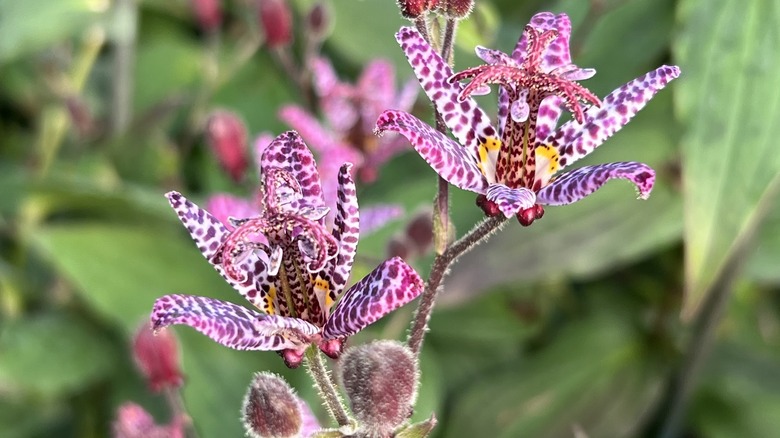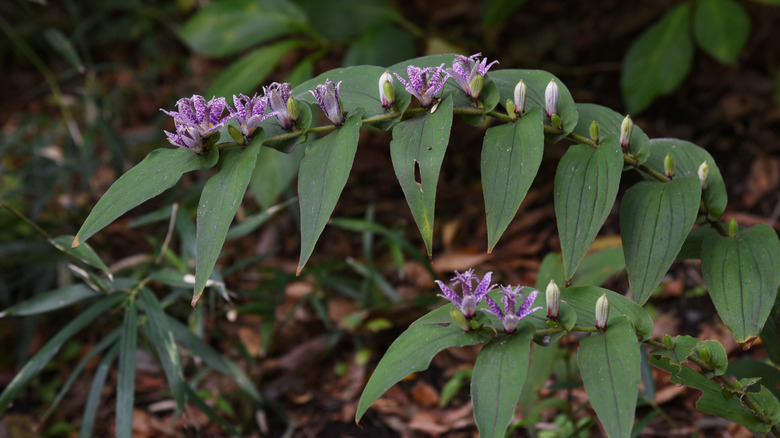If you want to add a pop of color to your shade garden that also happens to attract hummingbirds, look no further than the toad lily. With gorgeous flowers remniscent of orchids, this perennial hummingbird magnet will add a charming tropical vibe to your outdoor space. Their growth pattern is rhizomatic and clumping, so they will form a lush mass around wherever you plant them. However, they also make a stunning focal point in the garden if planted alone instead of grouped together. Toad lilies add an unmatched element of tropical vibrancy and color, and it just so happens that hummingbirds can’t get enough of their juicy nectar. Hummingbirds and tropical orchid-esque flowers? Doesn’t get much better than that, especially for a shade-loving plant.
It can be hard to find colorful flowering plants for shady areas of your yard. This is because most flowering plants do best in full sun. Perhaps the most attractive aspect of the toad lily is those gorgeous, tropical flowers that bring a whole new design element to a shady, mostly green garden. Toad lilies are also late-season bloomers, meaning they will give you a much-needed burst of color as we enter fall and winter. Because of their bloom time, they provide an amazing source of nectar for migrating hummingbirds during a time when most other flowers have already died back. However, if you’ve been struggling to attract hummingbirds, there may be a few key reasons why hummingbirds avoid your yard.
What is a toad lily?

Toad lily is the common name for lilies in the genus Tricyrtis spp. There are over 20 cultivated varieties of the toad lily. However, the most widely available ornamental species are the Tricyrtis formosana and Tricyrtis hirta. With a sprawling native range, toad lilies are native from the Himalayas to the Philipines, Japan, and Taiwan. Both varieties are found growing in shady, moist areas near river banks or other bodies of water.
The common name “toad lily” comes from the fact that their flowers are speckled and have sac-like nectaries that resemble warts on toads. Their namesake is odd, considering the flowers resemble orchids more than toads. Low-growing, reaching a maximum height of 36 inches, with gorgeous broad-leafed foliage, toad lilies excel in the understory. The stems also tend to arch in the same direction, creating a flowing and graceful appearance with a gorgeous tropical bloom emerging from the top of the plant. The flowers are star-shaped and range from white to different shades of purple. The blooms last several weeks, adding a lovely, late-season pop of color to your shade garden. The blooms are also shaped in a way that allows hummingbirds to feed and enjoy the sweet nectar that toad lilies provide.
How to incorporate toad lilies in your garden to attract hummingbirds

A gorgeous addition to any shade garden or woodland garden, toad lilies are excellent flowering plants to help bring hummingbirds to your yard. In terms of where to plant in your garden, their flowers are on the smaller side, so they are best planted where you can see them up close. For example, they make excellent border plants for shady gardens. You can plant them en masse and they will form an abundant clump covered in flowers come late summer or fall. Additionally, they can be planted alone and mixed in with other shade plants to diversify a bed. Wherever you decide to plant them, their sweet nectar will undoubtedly attract lots of bees, butterflies, and, of course, hummingbirds.
Hummingbirds are most active during August and September, which happens to be the time of year when toad lilies bloom, making them an excellent nectar source and hummingbird magnet. Additionally, hummingbirds are attracted to purple tubular flowers, which is why they are so drawn to toad lilies. While petite in nature, toad lily flowers are an important nectar source for all sorts of pollinators. To add a lovely pop of color to your shade garden and provide a valuable food source for hummingbirds in their most active season, plant some toad lilies in your yard!



